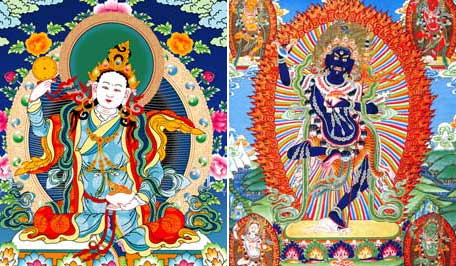| Videos | • Latest |
|
• Feature | • Sports | • Your Videos |
Tangka draws people with delicate strokes

 0 Comment(s)
0 Comment(s) Print
Print E-mail CNTV, February 9, 2012
E-mail CNTV, February 9, 2012
National Intangible Heritage Exhibition is being held in the National Agriculture Exhibition Center in Beijing. One highlight is the area displaying Tangka art, which is prevalent in the Tibet Autonomous Region. Visitors can see top class painters demonstrating the timeless art laden with religious stories as the theme.
 |
|
Painted on paper or cloth, Tangka paintings mainly depict stories of Buddhas. |
Featuring exquisite depiction of characters, Tangka art takes up a large amount of space at the exhibition. The largest Tangka painting stretches 17 meters long, but visitors are often drawn to the one only inches long. These require a magnifying glass to see clearly.
A visitor said, "We normally see big Tangkas; small ones like this is rare. But you can see many things portrayed in it."
A visitor said, "You can't see it clearly without a magnifier. This is my first time to see a painting like this."
Painted on paper or cloth, Tangka paintings mainly depict stories of Buddhas. With the help of a magnifier, one can see the delicate patterns concealed in the Buddha's aurora and clothes. The lines are as thin as hair, but are smooth and well delineated. Viewers simply stand in awe at the superb skills of the painters.
Niangben, inheritor of Tangka art, said, "The pigments are all from ores; the color should just be OK, no too light not too thick. Also, each stroke should be accurate. Your hand should be very steady."
|
Painted on paper or cloth, Tangka paintings mainly depict stories of Buddhas. |
The painter says he makes all the tools himself. The brush is made of squirrel's fur. Because the lines he draws are too thin and can't be seen clearly with the naked eye, the artist must paint each work allowing his feelings to lead the brush wherever it goes.
Niangben said, "Could you paint another piece like this now? It's very difficult to paint one like this. Because I drew this one when my heart was very quiet. Now, too many things. I can't reach that quiet state of mind."
Vibrant colors, and delicate strokes are what makes Tangka stand out from other styles of painting. But according to another Tangka painter, to accurately render the expressions on the characters' faces is the most difficult part of the painting.
Xi He Dao, inheritor of Tangka art, said, "Nose, eyes and mouth, this is the most difficult. Because it's the expression that makes the character really come to life."
Having reached his seventies, this painter still has good eyesight and a stable hand. He says Tangka portrays Buddhist characters in a realistic way. The expression on Buddhas should be both dignified and amiable. Only a skillful painter can achieve that.
The painter says in his hometown, there are thousands who are engaged in the art. And thanks to the government support in both policy and funds, the art has been well preserved and promoted. It has also become a pillar industry for locals in their road to prosperity. As nationally-nominated inheritors, it is their responsibility to introduce the art to more people.







Go to Forum >>0 Comment(s)